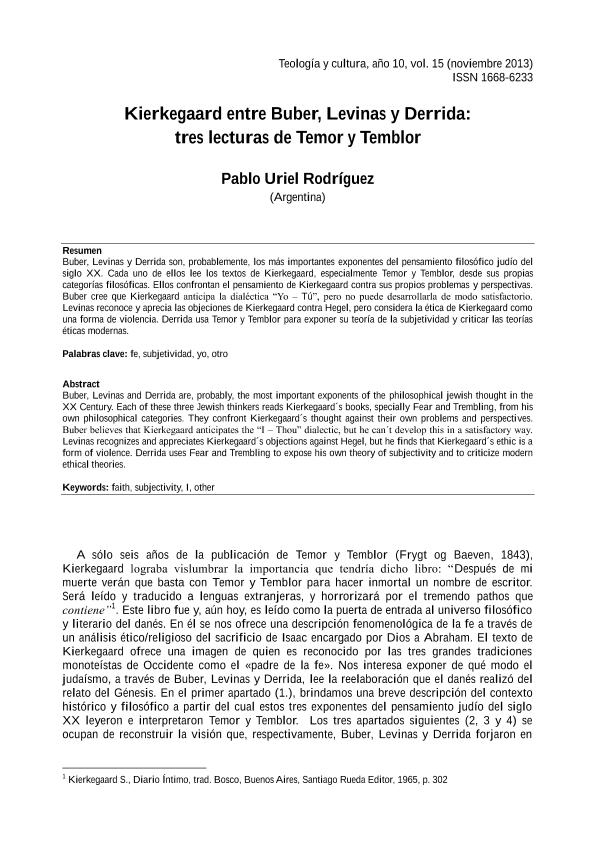Artículo
Buber, Levinas y Derrida son, probablemente, los más importantes exponentes del pensamiento filosófico judío del siglo XX. Cada uno de ellos lee los textos de Kierkegaard, especialmente Temor y Temblor, desde sus propias categorías filosóficas. Ellos confrontan el pensamiento de Kierkegaard contra sus propios problemas y perspectivas. Buber cree que Kierkegaard anticipa la dialéctica “Yo – Tú”, pero no puede desarrollarla de modo satisfactorio. Levinas reconoce y aprecia las objeciones de Kierkegaard contra Hegel, pero considera la ética de Kierkegaard como una forma de violencia. Derrida usa Temor y Temblor para exponer su teoría de la subjetividad y criticar las teorías éticas modernas. Buber, Levinas and Derrida are, probably, the most important exponents of the philosophical jewish thought in the XX Century. Each of these three Jewish thinkers reads Kierkegaard´s books, specially Fear and Trembling, from his own philosophical categories. They confront Kierkegaard´s thought against their own problems and perspectives. Buber believes that Kierkegaard anticipates the “I – Thou” dialectic, but he can´t develop this in a satisfactory way. Levinas recognizes and appreciates Kierkegaard´s objections against Hegel, but he finds that Kierkegaard´s ethic is a form of violence. Derrida uses Fear and Trembling to expose his own theory of subjectivity and to criticize modern ethical theories.
Kierkegaard entre Buber, Levinas y Derrida: tres lecturas de "Temor y Temblor"
Fecha de publicación:
10/2013
Editorial:
A. F. Roldán
Revista:
Teología y Cultura
ISSN:
1668-6233
Idioma:
Español
Tipo de recurso:
Artículo publicado
Clasificación temática:
Resumen
Palabras clave:
Kierkegaard
,
Judaísmo
,
Temor y Temblor
Archivos asociados
Licencia
Identificadores
Colecciones
Articulos(SEDE CENTRAL)
Articulos de SEDE CENTRAL
Articulos de SEDE CENTRAL
Citación
Rodríguez, Pablo Uriel; Kierkegaard entre Buber, Levinas y Derrida: tres lecturas de "Temor y Temblor"; A. F. Roldán; Teología y Cultura; 15; 10-2013; 69-90
Compartir




